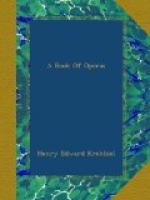A musical delineation of a witch’s ride separates the first and second acts. It is a garishly colored composition beginning with a pompous proclamation of the “Theme of the Witch":—
[Musical excerpt]
This is interwoven with echoes from the song of the broom-maker, and, as might be expected, a great deal of chromatic material, such as seems indispensable in musical pictures of the supernatural. Towards the close the weird elements gradually disappear and give way to a peaceful forest mood, pervaded by a long-drawn melody from the trumpet, accompanied by sounds suggestive of the murmuring of trees. The parting of the curtain discovers a scene in the depths of the woods. Gretel sits under a large tree weaving a garland of flowers. Hansel is picking strawberries. The sun is setting. Gretel sings another folk-song, the meaning of which is lost to those who are unfamiliar with the song in the original. It is a riddle of the German nursery: “A little man stands in the forest, silent and alone, wearing a purplish red mantle. He stands on one leg, and wears a little black cap. Who is the little man?” Answer:—the Hagebutte; i.e. the rose apple, fruit of the rose tree. After the Witch’s ride, nothing could be more effective in restoring the ingenuous mood essential to the play than this song, which is as graceful and pretty in melody as it is arch in sentiment. With the dialogue which follows, a variation of the closing cadence of the song is sweetly blended by the orchestra. Hansel crowns Gretel Queen of the Woods with the floral wreath, and is doing mock reverence to her when a cuckoo calls from a distance. The children mimic the cry, then playfully twit the bird with allusions to its bad practice of eating the eggs of other birds and neglecting its own offspring. Then they play at cuckoo, eating the strawberries in lieu of eggs, until the basket is empty. They remember the threat of their mother, and want to fill the basket again, but darkness is settling around them. They lose their way, and their agitated fancy sees spectres and goblins all around them. Hansel tries to reassure his sister by hallooing, and scores of voices send back echoes, while the cuckoo




